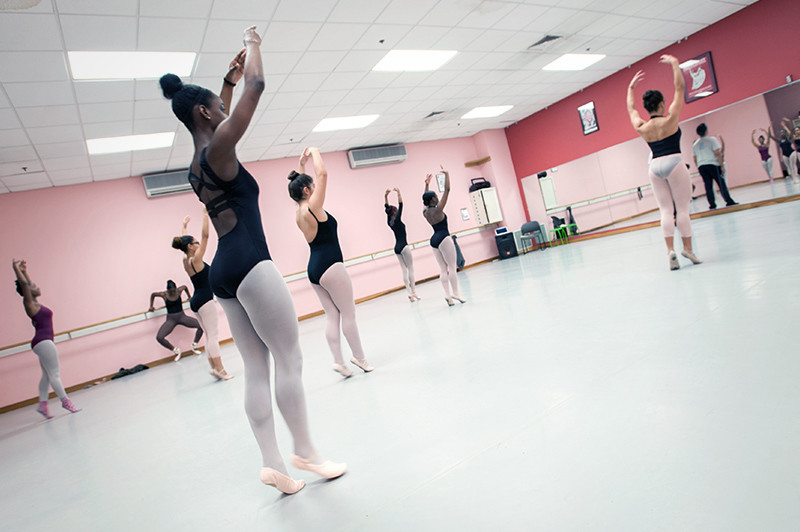Hip pain is different in female dancers: New insights from dynamic ultrasound

Dancers put unique demands on their hips, achieving extreme ranges of motion that can strain the joints and damage supporting tissues around them. Not surprisingly, hip injuries account for up to 17 percent of injuries in dancers and 27 percent among professional dancers.
Microinstability — no small problem for dancers
Conditions such as hip dysplasia and impingement are well studied. In recent years, however, hip and sports medicine specialists at Boston Children’s Hospital have expanded their focus to include microinstability, excess movement of the ball (femoral head) inside the hip socket (acetabulum).
“We believe micro motions inside the hip joint overload the cartilage, muscles, and tendons around the joint,” says Andrea Stracciolini, MD, director of Medical Sports Medicine at Boston Children’s Hospital. The condition, also known as femoroacetabular translation, can lead to pain, impaired function, and early osteoarthritis.
In a study published in the British Medical Journal Open Sport and Exercise Medicine, Stracciolini and her colleagues in the Sports Medicine Division analyzed hip microinstability in dancers and other athletes.
The team’s research sheds light on this little-understood but clinically relevant condition. It also points to the potential of dynamic hip ultrasonography to support more accurate diagnoses, non-operative therapies, and more informed surgical planning for patients who need surgery.
In dancers, painful hips are often unstable hips
Using dynamic hip ultrasound, the team compared the incidence and severity of microinstability in:
- female dancers with hip pain
- female dancers without hip pain
- non-dance female athletes
Of 171 subjects (average age 22), 62 were dancers with hip pain. Non-dance participants’ primary sports included gymnastics, cheering, figure skating, soccer, and basketball.
In a further sub-analysis, researchers compared a small cohort of 34 symptomatic dancers to 53 asymptomatic dancers of comparable age, height, and body mass index.
Results
Dancers with hip pain tended to have greater microinstability than:
– non-dance athletes with hip pain
– dancers with no hip pain
Nearly two thirds of dancers with hip pain also met the criteria for hypermobility.
The results support a relationship between hip microinstability and hip injury in dancers. The fact that microinstability was less common in non-dance athletes with hip pain suggests that their sports predispose them to different types of hip injuries.
Further, the greater incidence of hypermobility in dancers with hip pain than non-symptomatic dancers could indicate that extreme ranges of hip motion that can serve as an advantage in dance may also increase dancers’ risk.
Dynamic hip ultrasonography: Seeing hips in motion
Boston Children’s is a pioneer in the use of dynamic hip ultrasound to diagnose hip injuries.
In 2019, Stracciolini and her colleagues published a study showing that dynamic hip ultrasound can reliably assess microinstability. Since then, the clinicians have continued to explore ways that ultrasonography can be used to inform management of complex hip pain in dancers and other athletes.
Ultrasound gives us another piece of the puzzle to understand microinstability.”
Andrea Stracciolini, MD
Unlike static images produced by MRI and radiologic imaging, dynamic hip ultrasound allows clinicians to see inside a patient’s joint as they move through a variety of positions. Patients can provide real-time feedback to help pinpoint which positions cause them pain. Ultrasound is also more efficient, safe, and cost-effective that traditional imaging.
“Ultrasound gives us another piece of the puzzle to understand microinstability,” says Stracciolini. “The next step will be to establish normal values in different athletes: dancers, soccer players, and swimmers for instance, so that clinicians can use ultrasound to differentiate between a healthy hip and a damaged hip.”
Learn more about the Sports Medicine Division, Child and Young Adult Hip Preservation Program, and Sports Ultrasound Clinic.
Related Posts :
-

AI could change the way we look at hip preservation
Orthopedic surgeons and biomedical engineers are trained to approach adolescent and young adult hip pain from two different perspectives. Surgeons ...
-

Nicole and Alana: A friendship formed in dance
Nicole Zizzi and Alana Rochford are dancers who met for the first time at an audition. For Nicole, who is 27, ...
-

Jenna’s comeback from PAO surgery
By the time Jenna was 14, her off-and-on hip pain had become an always-on issue. The accomplished soccer player and runner ...
-

The surprisingly specific genetics of joint disease
A new study provides unexpected insights into the biology of two common, heritable orthopedic conditions: developmental dysplasia of the hip (...





